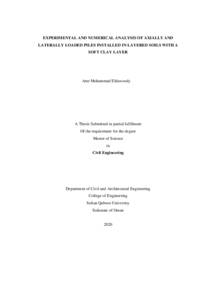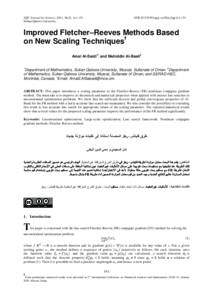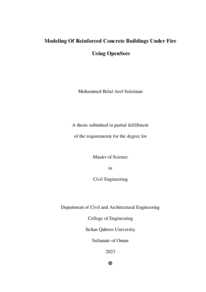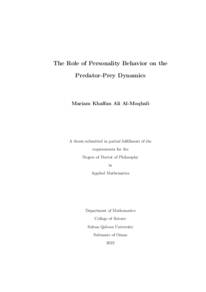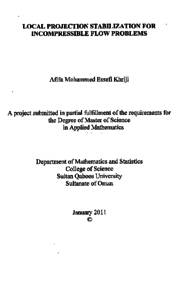وثيقة
Experimental and numerical analysis of axially and laterally loaded piles installed in layered soils with a soft clay layer.
المعرف
Al-Dawoody, Amr Mohammad (2020). Experimental and numerical analysis of axially and laterally loaded piles installed in layered soils with a soft clay layer (Master thesis, Sultan Qaboos University, Muscat, Oman).
الناشر
Sultan Qaboos University.
ميلادي
2020
اللغة
الأنجليزية
الموضوع
الملخص الإنجليزي
The objective of this experimental and numerical analysis research was to study the
response of reinforced concrete bored piles in layered soils with a soft clay layer under
axial and lateral loads. The first part of the study consisted of analysis of the full-scale
pile load tests. This is followed by development of a numerical model and was validated
using the results of the full-scale pile load tests. The full-scale pile load tests location was
at Duqm Integrated Power and Water Plant Project at Duqm City – Sultanate of Oman.
The site for the full scale consists of 3.0 m of sand overlying 4.50 m of soft clay that
extends to the bedrock. The groundwater table was about 1.4 m below the ground surface.
The full-scale tests were performed independently on two identical piles, one pile was
tested for axial loading and the other for lateral loading. The piles were reinforced
concrete bored piles with a 600 mm diameter and 16.0 m length. The test load for the
axially loaded pile axial was 2750 kN whereas it was 100 kN for the laterally loaded pile.
Two types of numerical models were developed in this research, one was axisymmetric
two-dimension model for the axially loaded pile. The second one was a threedimensional model for the laterally loaded pile and for the combined loading. The fullscale testes results showed the load-settlement curve for axially loaded pile, and the loadlateral deformation curve for the laterally loaded pile. The numerical model showed
perfect agreement with the results of the axial load test results and good agreement with
the results of the lateral load test.
The results show that the thickness of the soft clay significantly increases the settlement
of the axially loaded piles. On the other, the effect of the soft clay layer on the
deformations of the laterally loaded piles depends on the location of the soft clay layer
below the ground surface. The lateral deformations increase significantly with the
thickness of the soft clay layer, if the layer is within less than 3.0 m or 4 to 5 times the
diameter of the pile below the ground surface. However, the soft clay has no effect on
the pile lateral deformation of the pile if the clay is below 3 m (5 D) under the ground
surface. Moreover, choosing the wrong soil model could lead to wrong results even when
using the same soil parameters. It was found that the use of Modified Mohr-Coulomb
model for all layers was the most suitable model. Furthermore, the groundwater table
location affects the lateral deformation, while it had minimal effect on the pile settlement.
Additionally, combined loading leads to an increase of both the pile settlement and lateral
deformation. Finally, Increasing the slenderness ratio will increase both the pile
settlement and lateral deformation. The lateral load increased the pile settlement by 14%
while the axial load increased the pile lateral deformation by 9%
المجموعة
URL المصدر
الملخص العربي
الهدف الأساسي من هذه الدراسة التجريبية والعددية هو دراسة تصرف خوازيق الخرسانة المسلحة المصبوبة في الموقع في تربة متعددة الطبقات تحتوي على طين رخو تحت تأثير الأحمال الرأسية والجانبية. الجزء الأول من هذه الدراسة يتضمن تحليل تجربتين تحميل على خوازيق كاملة الحجم يتبع ذلك تطوير نموذج عددي والتحقق منه باستخدام نتائج تجارب التحميل. يتكون الموقع التي تم عمل الأختبارات به من طبقة من الرمل تتبعها طبقة من الطين الطري التي تمتد حتى ظهور الصخر الأم. تم عمل تجربتين تحميل منفصلتين إحداهما باستخدام حمل رأسي فقط والأخرى باستخدام حمل افقي لخازوقين منفذين في هذا الموقع. يقع موقع اختبار الخوازيق داخل محطة الدقم المتكاملة للكهرباء والمياه التي تقع في مدينة الدقم، سلطنة ُعمان. الخوازيق محل الأختبار كانت خوازيق من الخرسانة المسلحة المصبوبة بطريقة التفريغ. تتكون طبيعة التربة في الموقع من 3 أمتار من الرمل تتبعها 5.4 متر من الطين الرخو الذ ي يمتد حتى الصخر الأم. كانت المياه الجوفية في الموقع على عمق 40.1 متر من سطح الأرض. تم تنفيذ اختباري التحميل بشكل مستقل على خازوقين متماثلين. تم تحميل أحد الخوازيق بحمل رأسي والأخر بحمل أفقي. الخوازيق كانت من الخرسانة المسلحة ذات قطر 600 مم . كان حمل الأختبار الرأسي 2750 كيلو نيوتن وحمل الأختبار الجانبي 100 كيلو نيوتن. وبعمق ستة عشر متراً تم تطوير نموذجين عددين أحدهما ثنائي الأبعاد متماثل حول محوره تم استخدامه لتمثيل تجربة التحميل الرأسية. النموذج العددي الثاني كان ثلاثي الأبعاد وتم استخدامه لتمثيل تجربة التحميل الجانبية والحمل المدمج. تضمنت نتائج تجارب التحميل للخازوق الحصول على منحنى الأحمال مقابل هبوط الخازوق الرأسي وأيضا منحنى الأحمال مقابل حركة الخازوق الأفقية. أظهرت نتائج التحليل العددي تطابق تام مع نتائج تجربة التحميل في الحمل الرأسي وتطابق جيد في نتائج الحمل الجانبي. أظهرت نتائج الدراسة أن سمك طبقة الطين لها تأثير كبير على هبوط الخازوق في حالة الحمل الرأسي. بينما في حالة الحمل الأفقي فإن تأثير طبقة الطين كبير في حالة ظهورها على عمق من صفر إلى 0.3 م او 4 إلى 5 مرات قطر الخازوق من سطح الأرض. رغم ذك فإن طبقة الطين ليس لها تأثير إذا ظهرت على عمق أكبر من 5 مرات قطر الخازوق من سطح الأرض. أظهرت أيضا أن الختيار نموذج خاطئ لتمثيل التربة عدديا يمكن أن يؤدي إلى نتائج خاطئة حتى لو تم استخدام خواص تربة مماثلة. لقد وجد أن استخدام نموذج مور-كولومب المعدل هو أكثر مالئمة في تلك الحالة. بالأضافة لذلك، فإن عمق المياه الجوية له تأثير كبير على حركة رأس الخازوق في حالة الحمل الأفقي. بينما ليس لها تأثير تقريبا في حالة الحمل الرأسي. عالوة على ذلك، فإن الأحمال المدمجة تؤدي إلى زيادة في كال من هبوط الخازوق وحركته الأفقية. فقد زاد الهبوط الرأسي للخازوق في حالة وجود حمل أفقي بنسبة 14 % , بينما أدى وجود الحمل الرأسي إلى زيادة الحركة الأفقية بنسبة 9 .%وأخيرا، فإن الدراسة اظهرت أن بزيادة نسبة النحول للخازوق تزيد قيمة كل من الهبوط الرأسي والحركة الأفقية.
قالب العنصر
الرسائل والأطروحات الجامعية

